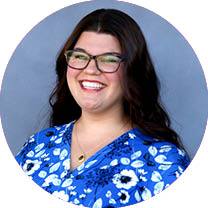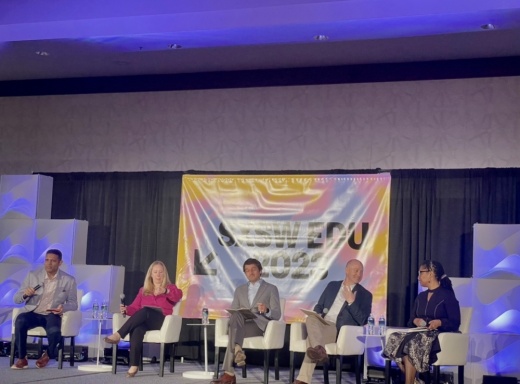What happened: During a SXSW EDU panel titled “Expanding Pathways in Postsecondary Education” on March 6, host Hari Sreenivasan asked a panel of experts in the education industry the essential question: Is a four-year degree the only way to success? The panel also addressed employers’ recent shift toward seeking out students with nontraditional higher education experiences to the workplace.
What they’re saying: “When we were 17, how many of us knew what we wanted to be when we grew up? Students should have the joy and privilege to choose and experience things that work for them with the support for them to change their minds,” panelist Aisha Francis said.
The bottom line: Higher education experts believe a four-year degree is no longer the preferred option to vouch for students’ skills, and employers are increasingly seeking students with technical experience for the workforce.
The panel of speakers included:
- Aisha Francis, president and CEO of Benjamin Franklin Cummings Institute Of Technology
- Hudson Baird: co-founder and executive director at PelotonU
- Julie Lammers: senior vice president of advocacy and corporate social responsibility at American Student Assistance
- Dan Fisher, president and CEO at ECMC Group
An evolving labor market and economic conditions are major factors in the shift in employers’ expectations for students joining the workforce.
Lammers said systems of higher education have changed significantly over the past two years in part due to COVID-19. Employers are responding to market failure and the gap between the credentials companies want from students with a postsecondary education and what they are getting.
“As schools have been forced to change their models, increasingly, employers are saying, ‘Here are the skills we want,’” she said.
Francis said Franklin Cummings Tech is addressing this issue by offering students an option to improve their earning capacity as well as their potential to support themselves and their families.
Additionally, Franklin Cummings Tech's model is finding more options to get students credentialed, which can help bend the cost curve of college, she said.
“There are tools in the toolbox; we just need more folks to pick them up,” she said.
To make this change a reality, Francis said the U.S. Department of Labor and Department of Education must work in tandem to find policies and establish funding sources for a reimagined higher education system.
Reimagining traditional college infrastructure
Baird said as a society, individuals need to reimagine the infrastructure of higher education because as it exists, there are structural barriers that turn away the majority of students.
“The traditional semester-based model was designed for rich white men and has an infrastructure which requires students to be on campus full time and dedicate themselves solely to studies,” he said.
For many students, the residential four-year experience is not viable.
Fisher said when thinking about higher education options, all students—and particularly marginalized students—are concerned about policy, transportation, food and commodities.
“What students are asking is: What is the value proposition [of higher education], and how do I make the transition without adding to crushing student loan debt?”
Fisher said as a whole, American society should be looking at the full spectrum of interested constituents in higher education, which includes employers, policymakers and students.
By the numbers
- In a 2022 study with Jobs for Future, 70% of employers said a bachelor’s degree is not enough to say whether a graduate is proficient in their skills, but it has been the default option. (Lammers)
- 80% of students think about their postsecondary education every week and feel incredible pressure to attain a four-year degree, according to an ECMC study focused on underserved and first-generation college students. (ECMC study, Fisher)
- 50% of these students think about their postsecondary education every day.
- Only 40% of students from low-income first-generation or minority backgrounds feel college is necessary to success. (ECMC study, Fisher)
- Only 8% of these students feel prepared to make the decision to undertake higher education. (ECMC study, Fisher)
- Pell Grants are not available for programs shorter than 16 weeks. (Lammers)
Lammers said early exploration and exposure to multiple higher education pathways are vital for students to make informed decisions about their future.
“We can’t isolate the postsecondary experience from what kids have already done and experienced,” she said. “They need exploration, experience ... [and] a greater breadth of experience in K-12 to understand the multitude of options available to them, " Lammers said.
In addition to understanding the available options, the options themselves must be high quality.
Sreenivasan asked the panel if there was worry that emphasizing other higher education models would lead to the creation of an underclass in which trade school students would likely end up employees while students with four-year degrees would become CEOs.
Fisher said he is not concerned about this because the goal is to increase the amount of information available to students and not necessarily to funnel people into certain choices.
Baird said he was very worried about the creation of an underclass because the college-not-being-necessary narrative is largely being pushed by people with college degrees. He said avoiding that issue would lie in employers finding other meaningful ways of validating credentials.
Changing the narrative
Francis said the importance of shifting the perceptual landscape regarding postsecondary education options involves a shift in nomenclature and design.
For example, at Franklin Cummings Tech, students are called “New Majority Learners.”
“Thinking about how we use language and then getting [people] to adopt that language will help with some preset perception challenges,” she said.
Lammers said changing the narrative also lies in having funding available for these pathways, including short-term options.
For example, students cannot receive a Pell Grant for any program less than 16 weeks long. If students have an eight-week opportunity, there is no funding available.
Lammers said this contributes to an issue in perception that says if the government will not fund this option, it is a worthy or meaningful investment.
Read more information about American Student Assistance, Franklin Cummings Tech, ECMC survey findings and PelotonU. Read more about the SXSW EDU panel here.





